Energetic Principles of Light and Color
Color Light Therapy is a part of the modern device supported procedures in the naturopathic practice. Its origins are old because color light therapy originally arose from Heliotherapy (helios, Greek = sun), the medical treatment with sunlight. Physically light and color are well defined. Sunlight is a part of the electromagnetic spectrum and consists of approximately 42% infrared light (“thermal radiation”), 51% visible light and about 6% ultraviolet light (UV-light).
The light we can see with our eyes, the optically discernible range of the electromagnetic spectrum, shifts in a range between 380 to 780 nm wave lengths. Infrared light is used primarily in thermotherapy for treatment of pain, UV-light in dermatology; for example, UV-B light (especially 311 nm) for psoriasis or UV-A light (320-380 nm) for atopic eczema.
Above all, Color Light Therapy releases resonance effects in our body and induces distribution of neurotransmitters and hormones.
Every color of the sunlight spectrum releases a specific reaction in our organism. The reaction levels are different. Colors have an effect emotionally and spiritually, as well as on a metabolic and structural level.
Example1: Orange – Moving into a state of flux
Emotional-Spiritual level: De-stressing, tonic, antidepressant
Metabolism level: Promotes the gastric juices, increased appetite
Structural level: Relaxing (e.g., with hard muscle in the instep [myogelosis])
Example 2: Violet – Contracting
Emotional-Spiritual level: concentrating, centering
Metabolism level: Contracts the stomach, hinders the appetite
Structural level: tightening (e.g. with cellulitis)
The absorption of light and color into the body occurs through the skin and eyes, but also through the Chakras (the energetic organs beyond our body) as well as food (in this connection the secondary vegetable dyes play a big role).
It is especially exciting that the body not only takes up light from the outside but even gives off an ultra weak cell radiation (“luminescence”), which became known as “BioPhoton radiation”. This light originates with cell division and is coherent, thus arranged laser-like. We are indebted to the research of the Russian Alexander Gurwitsch and, based on that, the work of the German professor Fritz-Albert Popp (“Der Mensch ist ein Lichtsauger” [The Human is a Light Suction Device*]) for knowledge about the existence of the “body’s own light production”.
The job of light: Cell communication
Our body is organized complexly. Approximately 30,000 to 100,000 chemical reactions per second run off at the same time in every cell. This is 1,000,000,000,000,000,000 = 1 quintillion reactions projected simultaneously on the body!
In order to guarantee the highly organized interaction of all the tissue functions in the body, only light, therefore photons, would be seen as computationally able to steer these processes with sufficient speed and precision.
Carlo Rubbia, Scientific Director of the “Institute for Advanced Sustainability Studies” in Potsdam, has summed it up. Together with Simon van der Meer he received the Nobel Prize for Physics in 1984. Together they solved the riddle that like matter, thus everything, which we see and can touch is assembled. Basically only 1 billionth of our world consists of mass, the remainder is pure energy. “The relation of energy quanta to mass particles is 1,000,000,000 (billion) to 1”. Simply translated:
Energetic processes have precedence over material processes.
Today, our DNA is considered to be the most important storage place of human cell radiation.
“The internal order of biological organisms is in connection with the sunlight.” (Erwin Schrödinger)

The Perspective of Far Eastern Medicine
From the view of Chinese Medicine light energy – brightness and warmth – is assigned to the Yang principle (“the sunny side of the mountains”), darkness and cold however to the Yin (“the shady side of the mountains”).
Our “life’s breath” Chi is fed from different energy sources, among them also light:
- Hereditary energy
- Food energy
- Breath energy
- Defensive energy
- Cosmic energy (sunlight!)
- Sexual energy
Our meridians are able to lead this Chi. As a result, acupuncture points function as energy and light floodgates. Among other things light enters into the body through the acupuncture points and can also leave the organism again through them.
The correct color at the correct place works miracles.
Chromotherapy
The India-born Dinshah Ghadiali developed the System of 12-Color Chromotherapy (Table 1). He was less concerned with acupuncture, but rather was inspired by Dr. Edwin D. Babbit with “The Principles of Light and Color” and developed numerous color light irradiation therapy schedules for different illnesses.
Without having to have great knowledge of color therapy we know for example: Red has a stimulating (tonifying) affect and blue calms (sedates). With green, the color of harmony and according to Dinshah Ghadiali of “psychic balance”, we can almost do nothing at all wrong: Green has a balancing affect.
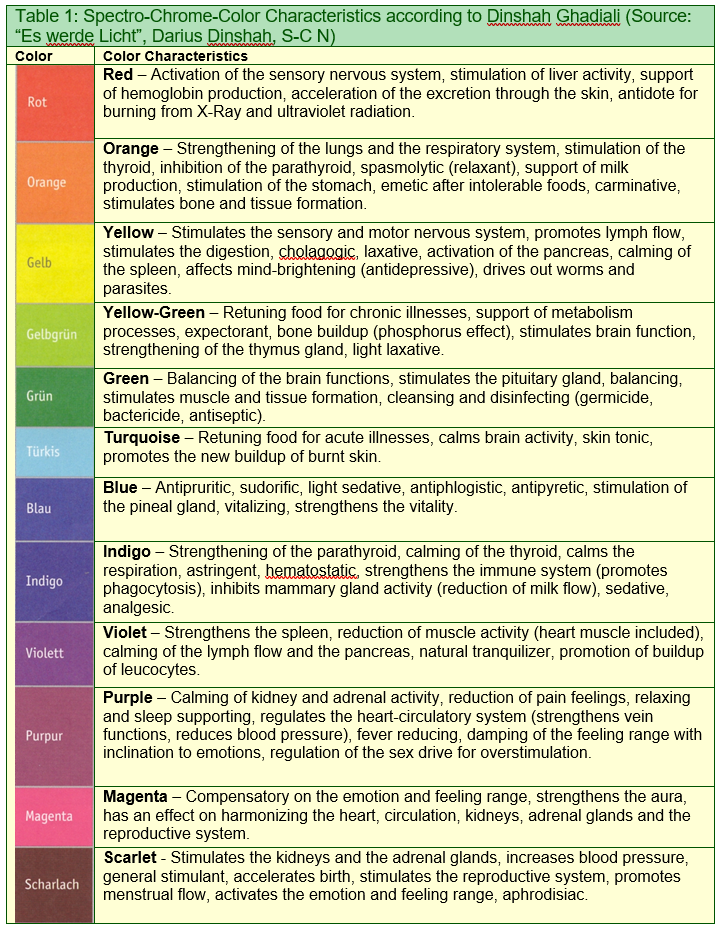 Translator’s Note regarding Table 1: You will notice that in this table and others in this article, I have copied her color tables leaving the German designations in place. Quite frankly, I did not want to “mess around” with the colors that she indicated or attempt to replace the colors with other samples that may or may not match her intent and shade. Thus the translation of each color appears at the beginning of each description, although most of them are self-evident.
Translator’s Note regarding Table 1: You will notice that in this table and others in this article, I have copied her color tables leaving the German designations in place. Quite frankly, I did not want to “mess around” with the colors that she indicated or attempt to replace the colors with other samples that may or may not match her intent and shade. Thus the translation of each color appears at the beginning of each description, although most of them are self-evident.
Color Meridian Therapy
Also very effective is the Color Meridian Therapy of Christel Heidemann. This classified every meridian to a color according to test findings.
As a physiotherapist she knew a lot about the connective tissue. On the basis of the knowledge that the main meridians run in the under the skin connective tissue and that “pathological” acupuncture points appear as “swelling” or “hardening” in the connective tissue, she found out that the “correct” color harmonized the connective tissue and the matching meridian, “wrong” colors led to a strengthening of the symptoms.
Heidemann classified the twelve main meridians first to the 12-figure color circle according to Itten and then showed the colors on the Chinese Meridian clock. Thus there originated the Color Meridian System that is safely used by the Color Therapy beginner (Table 2).

Each meridian possesses an activation color over the Midday-Midnight Rule, and receives the suitable sedation or calming color – and although for example the color yellow is assigned to the Heart Meridian and not, as one would expect, the color red (Fire Element), the system functions.
The traditional classification of the meridians to the colors of the Five Elements teaching remains untouched in the division according to Heidemann.
It results from their relationship with sunlight (at 12 o’clock noon the sun is at the highest and is the brightest: color yellow) and the lighting conditions of the sun in the course of the day.
It is practical and useful to apply the activation colors to the tonification points and the calming colors to the sedation points of the meridians, of course according to the known rule: “It’s better to tonify than to sedate.”
Christel Heidemann was a courageous woman. Her method stands partly in contradiction to the Chinese energy teachings. On the basis of her spiritual-scientific observations [in the field of the humanities], she exchanged the elements Wood and Water. Consequently she classified the Liver and Gall Bladder organs to the element Water as well as the Kidney and Bladder to the element Wood. Because of that treatment points divergent from TCM result.
Nevertheless, my experience is that the colors according to Heidemann are also effective on the traditional tonification and sedation points.
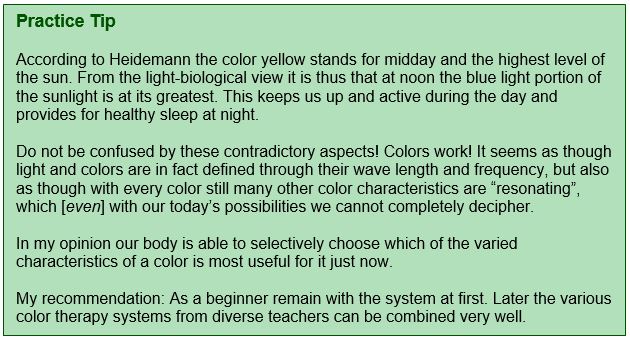
Balance of Energy Systems with Color
The first step is always the hardest. Therefore in my courses I try to pass on easily learnable color concepts. The resonance is wonderful over and over again.
Color and light have a wholesome effect on the body, mind and soul. That’s why I can only encourage you: Experiment with it!
The easiest form of light and color to work with is the irradiation of the so called Chakras. As subtle energy centers they are able to take up the energetic “oscillations” from the environment and also those of the colors, and to deliver them again. Each Chakra stands in close relation to a body region, organs, nerve networks, hormonal glands and emotional-spiritual life themes.
The Chakras have “favorite colors” with which they go into resonance. If a Chakra is “out of time”, the suitable resonance color brings it into balance (Table 3).
The actual color of a Chakra is independent of the resonance color.
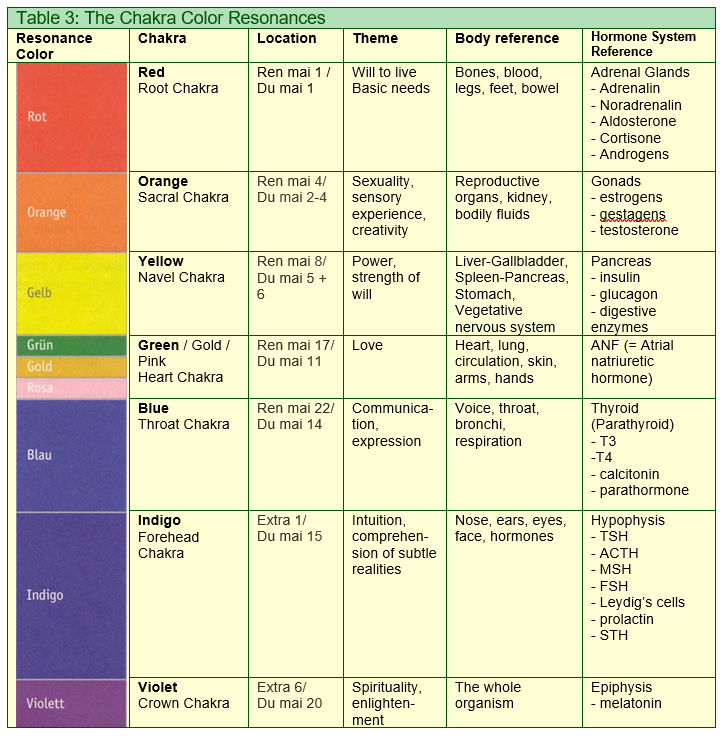

Irradiation Therapy Duration per Chakra:
- 5-10 minutes if you are using the simple irradiation therapy lamp (see instructions in box), and
- up to 30 minutes if you are working with a professional color therapy device (e.g. the Hydrosun-Strahler, MORA Color/Physio).
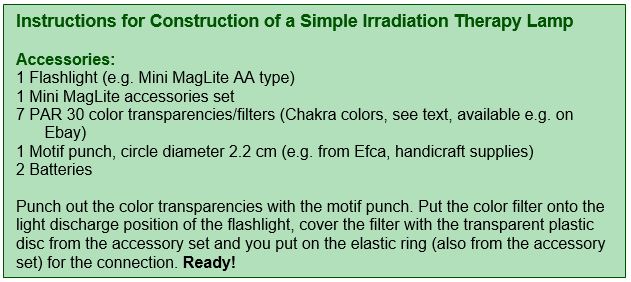
 Figure 1: Simple Irradiation Therapy
Figure 1: Simple Irradiation Therapy
Lamp, construction instructions in
accompanying box (Photo: Sonja Kohn)
Another irradiation therapy concept that I would like to introduce to you is a simple Color-Energy Balance on certain acupuncture points (Table 4). In this connection it is advisable, but is not compellingly necessary, that the light of the flashlight is focused with the attachment.

Illuminate each point for approximately 1 to 2 minutes first on one side of the body, then on the other side of the body. (Example: First Sp-6 right, then Sp-6 left.)
If you should get the idea to first treat a body-half completely and then the other, you create the principle of energy displacement and not of balance, which can possibly lead to reactions.
Results
A healthy body is distinguished by a high light-memory ability and the ability to transmit coherent light.
Illness is characterized by deficiency of light, incoherence and disturbed cell communication.
Color light therapy opens the blockages, brings along stagnation into the flow and brightens the mind; it is always used in the context of a holistic therapy concept, and as a rule the success is excellent.
Therapeutic work with light and color is alive, “bright” and colorful – thus you not only bring the life of your patients into full swing again, but also to your own!
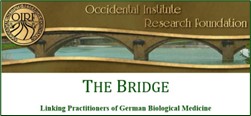 An Exclusive Translated Article for Supporters
An Exclusive Translated Article for Supporters
From THE BRIDGE Newsletter of OIRF
Published September 2014
From and article in CO’MED, Volume 20, June 2014
Machine Translation by SYSTRAN, Lernout & Hauspie, LogoMedia & Promt
Translation & redaction by: Carolyn L. Winsor, OIRF
© Copyright 2014, Sonja Kohn, HP, Germany
Follow this link to see Practice Application article.
* Also translates as a “light vacuum cleaner”!
Literature
- Kohn, Sonja; Schirmohammadi, Abbas: Meditative Reise durch die Chakras – MehrEnergie und Harmoniefür Körper, Geist und Seele (2 CDs). Shaker Media, 2014, ISBN 978-3-95631-124-6
- Raupach, Wiwi: Das Chakra-Aura-System. Mediengruppe Oberfranken – Fachverlage, Auflage, 2007
- Govinda, Kalashatra: Atlas der Chakras – Der Weg zur Gesundheit und spirituellem Wachstum. Irisiana Verlag, 2013
- Koepke-Staneva, Temenuga: Farbmeridiantherapie nach Christel Heidemann – Die Lehre vom Ätherleib in Ost und West. Verlag am Goetheanum, 2003
- Schnura, Thomas: Diagnose und Punktauswahl nach TCM (mit Zugang zum Elsevier-Portal). Urban & Fischer Verlag / Elsevier GmbH, Auflage, 2009



